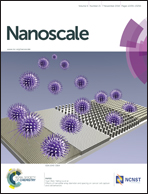An electric-field assisted growth control methodology for integrating ZnO nanorods with microstructures†
Abstract
The growth control of ZnO nanorods bridging over two microelectrodes in a three-electrode structure (the top cathode and anode, and the bottom gate) was realized using a wet chemical method with the assistance of an electric field generated by applying AC sine wave power on the top electrodes and a DC voltage on the bottom gate. A numerical control model for controlling the growth position, direction and density of ZnO nanorods on the microstructure was established based on the simulation of the electric-field distribution around the microstructures. The three input parameters in the numerical control model were defined as the peak-to-peak voltage of the AC sine wave (x1), the frequency of the AC sine wave (x2) and gate voltage (x3). Moreover, five output parameters (y1, y2, y3, y4, y5) in the model were defined as the electric field intensities at specific points on the electrodes to characterize the growth rate, direction, position and morphology of the ZnO nanorods integrated with the microelectrodes. The relationship between the defined outputs and inputs were established using 3rd polynomial fitting, which served as the numerical control model for the prediction of nanorod growth. The experimental results validated that growth control methodology provides us with an effective approach to integrate ZnO nanorods into devices.


 Please wait while we load your content...
Please wait while we load your content...